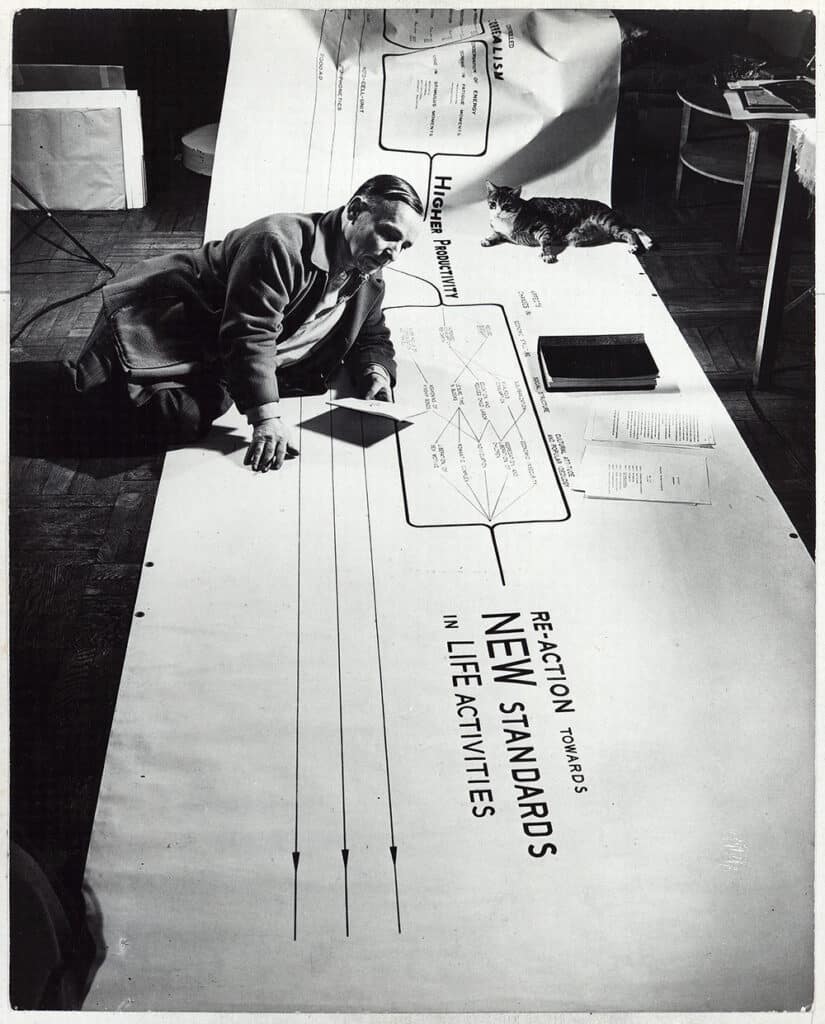Symposium
Thursday, October 20, 2022, 10 a.m. – 7 p.m.
Auditorium, University of Applied Arts Vienna
Vordere Zollamtsstraße 7, 1030 Vienna
Concept by Gerd Zillner and Wolfgang Fiel
One-day symposium in collaboration with the University of Applied Arts Vienna, marking the 25th anniversary of the Frederick Kiesler Foundation based in Vienna.
In the 1930s, Frederick Kiesler (1890-1965) developed the theory of Correalism as a transdisciplinary research method in architecture and design. It was based on the latest findings of systems theory, biology and the technical sciences and has called for the combination of empirical scientific research, holistic human-centred design (Correalism) and the practical testing of emergent knowledge (Biotechnique).
Kiesler’s neologism contains the terms co-realism and correlation, referring to the interrelation of three environments: the natural, the human and the technical environment. The human being is at the centre of these interrelations, which Kiesler also refers to as interacting forces. Having published the ground-breaking article “On Correalism and Biotechnique” in 1939, Kiesler’s Correalism- research in the 1940s and 1950s focused on the critique of “pseudo-functionalism” and modernism, which he saw as favouring the “arbitrary separation of architecture into art, technology and economy.”
With his work at the Laboratory for Design Correlation at Columbia University (1937-1941), Kiesler is considered a visionary pioneer of artistic teaching, trans-, inter- and cross-disciplinary work, as well as a trailblazer for artistic research.
The symposium emphasises the need of challenging the new pragmatism in architecture by re- visiting prospective scenarios of the past and imagining an archaeology of the future.
The 20th century was characterised by bold future scenarios, often discredited as utopian, in which architects claimed a central role in the analysis and design of social transformation. The “new” problem awareness developed under the influence of cybernetics and systems theory led to a paradigmatic expansion of the associated range of tasks.
In order to meet the complex challenges of the present with viable concepts for alternative “futures”, it is important to “tune-in” with those who paradigmatically stood for a critical and reflexive opening of the profession toward other disciplines. In addition to Frederick Kiesler, Richard Buckminster Fuller and Victor Papanek, among others, anticipated much of what is now called trans- or interdisciplinary working methods. Kiesler, Fuller and Papanek exemplify the synthesis of art, humanistic design, and technological innovation.
The lectures will be held in English.
Program
9.30 a.m. – 10 a.m.
Get Together
10 a.m. – 10.30 a.m.
Welcome and introduction
Rector Gerald Bast (University of Applied Arts Vienna) and
Christoph Thun-Hohenstein (Board members of the Frederick Kiesler Foundation)
10.30 a.m. – 1 p.m.
Co-Realities: Clarification of terms
Correalism. Articles, Manifestos, Manuscripts: Gerd Zillner (Director, Frederick Kiesler Foundation)
Correalism: Laura McGuire (University of Hawaiʻi at Mānoa)
News from the Archive of the Visionary: The Vision Machine: Dieter Bogner (Founding President Frederick Kiesler Foundation)
Heretical Modernism: Frederick Kiesler’s Framework of a “Design Science” Gert Hasenhütl (University of Applied Arts Vienna)
Discussion
1 – 2 p.m. Lunch Break
2 – 3.30 p.m.
Correlations: Historical context
Fuller-Kiesler-Lönberg Holm. The Structural Study connection and SHELTER Magazine, 1932: Joachim Krausse (Berlin)
Victor Papanek and Frederick Kiesler: A Real and Imagined Relationship: Alison Clarke (University of Applied Arts Vienna)
“Menschen, Kunst und Architektur. Ein Manifest des Korrealismus“. Frederick Kiesler‘s Response to Sigfried Giedion and the 6th CIAM-Congress 1947: Almut Grunewald (gta Archive, ETH Zurich)
Discussion
3.30 – 4 p.m. Coffee Break
4 – 4.15 p.m.
Project Presentation: INTRA Applied Correlation Laboratory, Doris Krüger (University of Applied Arts Vienna)
4.15 – 5.45 p.m.
Archeology of the future//Prospective scenarios of the past: Activation for the here and now, current discourse
Intro: Wolfgang Fiel (iCP, University of Applied Arts Vienna)
Homo spatius, Barbara Imhof (LIQUIFER Systems Group)
Micro performativity, Lucie Strecker (Artist and Researcher)
5.45 – 6 p.m. Break
6 – 7 p.m.
Panel Discussion (Moderation: Stephan Hilpold, derStandard)
Supported by:
Austrian Federal Ministry of Education, Science and Research
University of Applied Arts Vienna
City of Vienna – Department for Cultural Affairs
Federal Ministry Republic of Austria of Arts and Culture, Civil Service and Sport
Dorotheum
Wittmann Möbelwerkstätten
Credit: Frederick Kiesler on his „Metabolism Chart“, New York, 1947, Photographer: Ben Schnall
